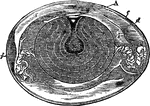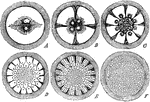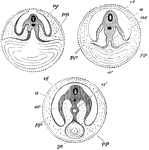Clipart tagged: ‘yelk’
Blastoderm of an Egg
Vertical section of area pellucida and area opaca (left extremity of figure) of blastoderm of a fresh…

Egg Germination
"Further development of hen's egg; after Haeckel: A, the mulberry mass of cleavage cells, b, same as…

Hen's Egg
" Fig 110 - Hens egg, nat. size, in section; from Owen, after A. Thompson. A, cicatricle or "tread,"…

Fowl Ovum
"Meroblastic ovum (yelk) of domestic fowl, bat. size, in section; after haeckel. a, the thin yelk-skin,…

The Segmentation of the Vitellus
"The first change in the parent-cell is that by which it becomes broken up into a mass of cells, each…

Development of the Yolk Sac
Diagram showing the three successive stages of development. Transverse vertical sections. The yolk sac,…